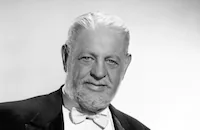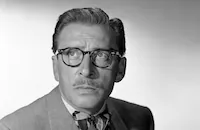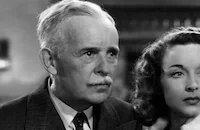Murder in Greenwich Village
Brief Synopsis
Cast & Crew
Albert S. Rogell
Richard Arlen
Fay Wray
Raymond Walburn
Wyn Cahoon
Scott Colton
Film Details
Technical Specs

Synopsis
Playgirl heiress "Lucky" Kathryn Cabot leaves the studio of artist Philip Morgan by way of a window, in order to escape his unwelcome attentions. Steve Jackson, an artist who lives below Philip, lends her some clothes as she is merely dressed in a swimsuit, and introduces her to his models, Antoinette, Flo, Flo's boyfriend Larry Foster and a pompous elderly man called "The Senator." The next morning, Kay learns that Philip was murdered. Kay convinces Steve to pose as her fiancé and provide her with an alibi. To repay Steve for his help, Kay helps him get an advertising job at International Chromium Corp., headed by her friend Rodney Hunter. Meanwhile, Philip's brother Rusty, determined to find Philip's murderer is following Kay. That night, Steve sneaks a group of models into Dutton's department store to shoot Chromium's ad. The next day, after attempting to blackmail Kay's father, Larry is found strangled to death. Steve is questioned by the police and subsequently loses the Chromuim account. That night Kay and Steve picnic on the beach but they quarrel when Steve learns that Kay arranged for his work with Chromuim. Later, Rodney asks Kay to accompany him to Paris and, on the rebound, she agrees. Meanwhile, police investigator Henderson finds proof that Kay was with Philip on the night of his murder. Steve stops Henderson from arresting Kay and races to keep her from incriminating herself by leaving the country. Then, Rusty confronts Kay, Steve and Rodney on board the ship and shoots Rodney after proving that he killed Philip. The police arrest Rusty, and Kay and Steve realize they love one another.

Director
Albert S. Rogell
Cast

Richard Arlen

Fay Wray

Raymond Walburn
Wyn Cahoon
Scott Colton

Thurston Hall
Marc Lawrence
Gene Morgan
Mary Russell

George Mckay

Leon Ames
Barry Macollum

Marjorie Reynolds

Howard Hickman
Gordon Demain
Eddie Fetherston
Dick Curtis
Bud Jamison
Bill Irving
Harry Hollingsworth
Jack Cheatham
Edward Earle
Nick Copeland
Vernon Dent
Al Herman
Wilson Benge
Edmund Cobb
J. G. Macmahon
George Chesebro
Crew
Lionel Banks
Irving Briskin
Harry Cohn
Lambert Day
Dick Fantl
Henry Freulich
Stephen Goosson
Kalloch
Wallace Macdonald
Sam Nelson
Robert T. Shannon
Michael L. Simmons
Morris Stoloff

Film Details
Technical Specs

Articles
Marc Lawrence (1910-2005)
Born Max Goldsmith on February 17, 1910, in the Bronx, Lawrence had his heart set on a career in drama right out of high school. He enrolled at City College of New York to study theatre, and in 1930, he worked under famed stage actress Eva Le Gallienne. Anxious for a career in movies, Lawrence moved to Hollywood in 1932 and found work immediately as a contract player with Warner Bros. (an ideal studio for the actor since they specialized in crime dramas). He was cast as a heavy in his first film, If I Had a Million (1932). Although his first few parts were uncredited, Lawrence's roles grew more prominent: a sinister henchman in the Paul Muni vehicle in Dr. Socrates (1935); a conniving convict aiding Pat O'Brien in San Quentin (1937); a menacing thug stalking Dorothy Lamour in Johnny Apollo (1940); the shrewdly observant chauffeur in Alan Ladd's breakthrough hit This Gun For Hire (1942); and one of his most memorable roles as Ziggy, a fedora wearing mobster in the Bogart-Bacall noir classic Key Largo (1948).
Lawrence, when given the opportunity, could play against type: as the prosecuting attorney challenging Tyrone Power in Brigham Young (1940); a noble aristocrat in the Greer Garson-Walter Pidgeon period opus Blossoms in the Dust; and most impressively, as a deaf mute simpleton in the rustic drama The Shepherd of the Hills (both 1941). Better still was Lawrence's skill at comedy, where his deadpan toughness worked terrifically as a straight man against the likes of Joe E. Brown in Beware Spooks (1939); Abbott and Costello in Hit the Ice (1943); Penny Singleton in Life with Blondie (1945); and Bob Hope in My Favorite Spy (1951).
After that, Lawrence's career took a turn downward spin when he was labeled a communist sympathizer during the Hollywood witch hunts of the early '50s. He was exiled in Europe for a spell (1951-59), and when he came back, the film industry turned a blind eye to him, but television overcompensated for that. Here he played effective villains (what else?) in a series of crime caper programs: Peter Gunn, Johnny Staccato, The Untouchables, Richard Diamond, Private Detective; and eventually made a welcome return to the big screen as a returning exiled gangster in William Asher's underrated mob thriller Johnny Cool (1963).
It wasn't long before Lawrence found himself back in the fray playing in some big box-office hits over the next two decades: Diamonds Are Forever (1971), The Man with the Golden Gun (1974), Marathon Man (1976), Foul Play (1978); and The Big Easy (1987). Sure he was cast as a gangster, but nobody could play a rough and tumble mob boss with more style or conviction.
Interestingly, one of his finest performances in recent years was in television, as a severely ill old man unwilling to accept his fate in a fourth season episode of ER (1997-98). His last screen role was just two years ago, as a nimble minded VP in Looney Tunes: Back in Action (2003).
In 1991, Lawrence published a memoir about his venerable career, Long Time No See: Confessions of a Hollywood Gangster that received much critical acclaim. He has also developed a cult following due to his appearances in such offbeat items as From Dusk to Dawn and Pigs aka Daddy's Deadly Darling, the 1972 horror film he directed and starred in with his daughter Toni. He is survived by his wife, Alicia; two children from a previous marriage, Toni and Michael; and a stepdaughter Marina.
by Michael T. Toole

Marc Lawrence (1910-2005)
Quotes
Trivia
Notes
The working title for this film was Park Avenue Dame.














